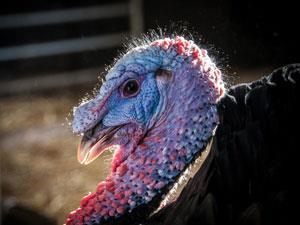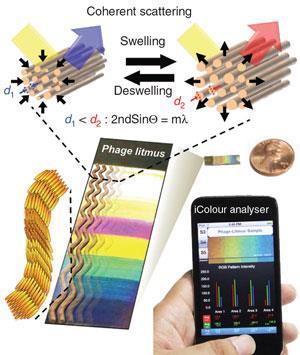
The sensor, developed by Seung-Wuk Lee from the University of California, Berkeley, and colleagues, is based on ordered bundles of a filamentous bacteriophage. When white light hits the bundles, it undergoes coherent scattering, producing light of a single colour. Shrinkage or swelling of the bundles in response to environmental factors such as moisture or volatile chemicals alters the spacing between the bundles, and therefore the colour of the scattered light. In a turkey’s neck, this effect is achieved through bundles of collagen whose spacing can be changed by the expansion of blood vessels.
Crucially, because the sensor is based on a self-replicating biological entity, it is possible to genetically engineer the peptide composition of the phage coat to enable it to bind to different substances with high specificity.
The team also developed a way to precipitate the phage bundles from solution onto a solid substrate. By controlling the concentration of phage and speed at which it is pulled out of solution, it is possible to obtain bundles of different diameter, which scatter light of different wavelengths. In this way the researchers can make a ‘phage litmus’ strip, with adjacent bands of bundles showing different colours. They have also developed a smartphone app that can map and analyse the colour changes.

‘The techniques we use are very common [ones] that anyone can do in the laboratory,’ says Lee. ‘Scale-up and manufacturing costs would be negligible once the system is developed.’
Fernando da Cruz Vasconcellos, an expert on light-based sensors at the University of Cambridge in the UK, is impressed by the work. ‘This is a very elegant and exciting advance to tackle the limitations in target analyte selectivity, a fundamental challenge in the development of sensors,’ he says. He adds that the ability to obtain tailored and specific target recognition motifs and genetically incorporating them into biological entities that can self-assemble into tuneable colorimetric sensors ‘holds enormous future potential for the entire field of sensing technologies’.






No comments yet